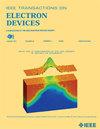Graph Representation Framework for Accelerating Atomic-Level Semiconductor Device Simulation
IF 2.9
2区 工程技术
Q2 ENGINEERING, ELECTRICAL & ELECTRONIC
引用次数: 0
Abstract
This article proposes a machine-learning (ML) method to accelerate atomic-level device simulation. The main idea is to utilize graph convolutional network (GCN) to predict the potential distribution of the device, aiming to expedite the time-consuming self-consistent calculation process of the transport-Poisson equation within the nonequilibrium Green’s function (NEGF) method. Using the network-predicted electrostatic potential distribution as the initial solution can accelerate the convergence speed of the above process without compromising the accuracy of NEGF calculations. Most importantly, this network introduces a new method for device representation using graphs. It explicitly encodes the coupling effect between the device’s scattering region (SR) and electrodes while effectively capturing quantum mechanical effects at the atomic level. This method offers a more reliable and physically significant approach to device encoding, providing fresh insights on merging ML with atomic-level device simulations.加速原子级半导体器件仿真的图形表示框架
本文提出了一种机器学习(ML)方法来加速原子级器件仿真。主要思想是利用图卷积网络(GCN)来预测器件的潜在分布,旨在加快非平衡格林函数(NEGF)方法中耗时的输运-泊松方程自洽计算过程。使用网络预测的静电势分布作为初始解可以在不影响NEGF计算精度的前提下加快上述过程的收敛速度。最重要的是,该网络引入了一种使用图表示设备的新方法。它明确地编码了器件散射区域(SR)和电极之间的耦合效应,同时有效地捕获了原子水平上的量子力学效应。这种方法为设备编码提供了一种更可靠和物理意义重大的方法,为将ML与原子级设备模拟合并提供了新的见解。
本文章由计算机程序翻译,如有差异,请以英文原文为准。
求助全文
约1分钟内获得全文
求助全文
来源期刊

IEEE Transactions on Electron Devices
工程技术-工程:电子与电气
CiteScore
5.80
自引率
16.10%
发文量
937
审稿时长
3.8 months
期刊介绍:
IEEE Transactions on Electron Devices publishes original and significant contributions relating to the theory, modeling, design, performance and reliability of electron and ion integrated circuit devices and interconnects, involving insulators, metals, organic materials, micro-plasmas, semiconductors, quantum-effect structures, vacuum devices, and emerging materials with applications in bioelectronics, biomedical electronics, computation, communications, displays, microelectromechanics, imaging, micro-actuators, nanoelectronics, optoelectronics, photovoltaics, power ICs and micro-sensors. Tutorial and review papers on these subjects are also published and occasional special issues appear to present a collection of papers which treat particular areas in more depth and breadth.
 求助内容:
求助内容: 应助结果提醒方式:
应助结果提醒方式:


